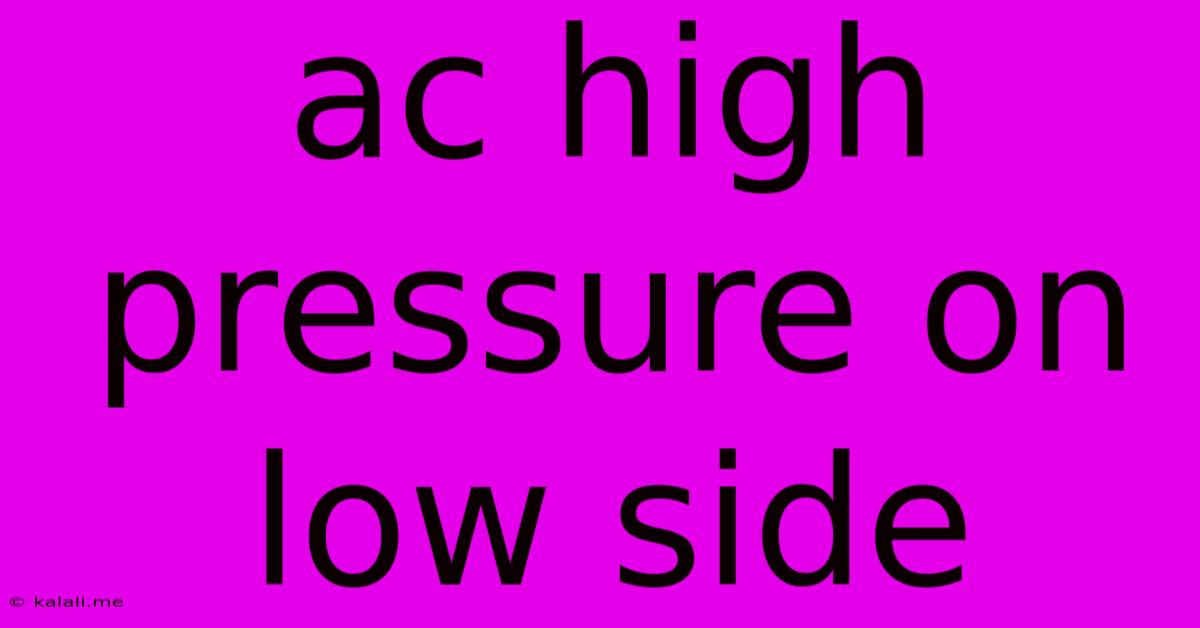Ac High Pressure On Low Side
Kalali
May 28, 2025 · 3 min read

Table of Contents
AC High Pressure on Low Side: Troubleshooting and Solutions
Meta Description: Experiencing high pressure on your AC's low side? This comprehensive guide explains the common causes, from refrigerant leaks to compressor issues, and provides troubleshooting steps for DIY fixes and when to call a professional.
High pressure on the low side of your air conditioning system is a serious issue that can significantly impact its performance and even lead to damage. Unlike a typical high-pressure situation on the high side, this indicates a problem that needs immediate attention. This article will walk you through the common causes of this anomaly, how to diagnose the problem, and when you should call for professional help.
Understanding Your AC System: High Side vs. Low Side
Before diving into the problem, it's crucial to understand the basic workings of an AC system. The refrigerant circulates through a closed system, undergoing changes in pressure and temperature. The high-pressure side is where the refrigerant is hot and compressed, while the low-pressure side is where it's cool and expanding. A high-pressure reading on the low side disrupts this crucial balance.
Common Causes of High Pressure on the Low Side
Several factors can contribute to high pressure in the low-pressure side of your AC unit. These include:
-
Refrigerant Leaks: A significant refrigerant leak is a primary suspect. Low refrigerant levels force the compressor to work harder, increasing pressure throughout the system, even on the low side. This increased pressure can be dangerous and lead to compressor failure. Look for signs of leaks, such as oil stains or hissing noises near the lines.
-
Restricted Airflow: Obstructions in the airflow path can cause the evaporator coil to freeze, restricting refrigerant flow and increasing pressure on the low side. This can be due to a dirty air filter, blocked vents, or even debris around the outdoor unit. Regular cleaning and maintenance are key to prevent this.
-
Faulty Expansion Valve or Metering Device: This component regulates the flow of refrigerant. A malfunctioning expansion valve can restrict refrigerant flow, leading to high pressure on the low side and potentially low pressure on the high side.
-
Compressor Issues: A faulty compressor can cause several problems, including overheating and increased pressure throughout the system. A failing compressor is a serious issue requiring professional attention.
-
Incorrect Refrigerant Charge: Too much refrigerant in the system can also lead to high pressure on the low side. This requires precise diagnosis and adjustment by an HVAC technician.
Troubleshooting Steps
While some minor issues might be solvable by homeowners with basic AC knowledge, others require a professional.
DIY Troubleshooting:
- Check the air filter: A clogged air filter is a common culprit. Replace it with a new one.
- Inspect for obstructions: Ensure there are no obstructions blocking airflow to or from the unit, both indoors and outdoors.
- Check for leaks (visually only): Look for any signs of refrigerant leaks around the lines and connections. Do not attempt to repair leaks yourself.
When to Call a Professional:
If the DIY troubleshooting steps don't resolve the issue, or if you suspect a more serious problem like a refrigerant leak, compressor malfunction, or expansion valve failure, it's crucial to contact a qualified HVAC technician. Attempting repairs beyond your skill level can worsen the problem and lead to costly repairs or safety hazards.
Preventing Future Problems
Regular maintenance is essential to prevent high pressure on the low side and other AC problems. This includes:
- Annual AC maintenance: Schedule professional inspections and tune-ups.
- Regular air filter changes: Change your air filter every 1-3 months, depending on usage and household conditions.
- Keep the unit clean: Regularly clean the condenser coils (outdoor unit) and remove any debris.
High pressure on the low side of your AC system isn't something to ignore. By understanding the potential causes and taking appropriate action, you can ensure the longevity and efficiency of your air conditioning system. Remember that safety is paramount, and professional help should always be sought when needed.
Latest Posts
Latest Posts
-
Will Dog Whistles Stop Dogs From Barking
May 30, 2025
-
How To Hang Frames On Cement Walls
May 30, 2025
-
Did Judith Die In Walking Dead
May 30, 2025
-
How To Find Past Wifi Connection Mac
May 30, 2025
-
How To Play Cut Throat Pool Racking
May 30, 2025
Related Post
Thank you for visiting our website which covers about Ac High Pressure On Low Side . We hope the information provided has been useful to you. Feel free to contact us if you have any questions or need further assistance. See you next time and don't miss to bookmark.